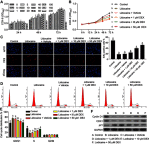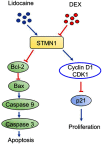Dexmedetomidine protects PC12 cells from lidocaine-induced cytotoxicity via downregulation of Stathmin 1
- PMID: 31308624
- PMCID: PMC6618032
- DOI: 10.2147/DDDT.S199572
Dexmedetomidine protects PC12 cells from lidocaine-induced cytotoxicity via downregulation of Stathmin 1
Abstract
Background: Understanding of lidocaine-induced neurotoxicity is not complete, resulting in the unsuccessful treatment in some clinical settings. Dexmedetomidine (DEX) has been shown to alleviate lidocaine-induced neurotoxicity in our previous cell model. However, the rationale for DEX combined with lidocaine to reduce lidocaine-induced neurotoxicity in the clinical setting remains to be further clarified in the detailed molecular mechanism. Methods: In this study, we established a cellular injury model by lidocaine preconditioning. Cell Counting Kit-8 (CCK-8) and 5-ethynyl-2'-deoxyuridine (EdU) proliferation assay kit were used to analyze cell proliferation. Cell apoptosis was measured by flow cytometry and Hoechst 33342 staining. Cell cycle progression was detected by flow cytometry. The protein expression levels were detected by Western blotting and immunofluorescence staining. Results: Our results showed that DEX dose-dependently restored impaired proliferation of PC12 cells induced by lidocaine,as reflected by the increased cell viability and EdU positive cells, which were consistent with the decreased expression of tumor suppressor protein p21 and increased expression of cell cycle-related cyclin D1 and CDK1. In addition, DEX dose-dependently reduced apoptotic PC12 cells induced by lidocaine,as reflected by the decreased expression of apoptosis-related Bax, caspase-3 and caspase-9 and increased expression of anti-apoptotic Bcl-2 compared to the cells only treated with lidocaine. Mechanistically, with gain-or-loss-of-function of STMN1, we showed that DEX-mediated neuroprotection by lidocaine-induced damage is associated with downregulation of STMN1 which might be an upstream molecule involved in regulation of mitochondria death pathway. Conclusion: Our results reveal that DEX is likely to be an effective adjunct to alleviate chronic neurotoxicity induced by lidocaine.
Keywords: STMN1; apoptosis; dexmedetomidine; lidocaine; neurotoxicity; proliferation.
Conflict of interest statement
The authors report no conflicts of interest in this work.
Figures







Similar articles
-
Dexmedetomidine protects against lidocaine-induced neurotoxicity through SIRT1 downregulation-mediated activation of FOXO3a.Hum Exp Toxicol. 2020 Sep;39(9):1213-1223. doi: 10.1177/0960327120914971. Epub 2020 Mar 31. Hum Exp Toxicol. 2020. PMID: 32228195
-
Dexmedetomidine inhibits activation of the MAPK pathway and protects PC12 and NG108-15 cells from lidocaine-induced cytotoxicity at its maximum safe dose.Biomed Pharmacother. 2017 Jul;91:162-166. doi: 10.1016/j.biopha.2017.04.084. Epub 2017 May 23. Biomed Pharmacother. 2017. PMID: 28463790
-
Dexmedetomidine Attenuates Glutamate-Induced Cytotoxicity by Inhibiting the Mitochondrial-Mediated Apoptotic Pathway.Med Sci Monit. 2020 May 18;26:e922139. doi: 10.12659/MSM.922139. Med Sci Monit. 2020. PMID: 32419697 Free PMC article.
-
Dexmedetomidine Protects PC12 Cells from Lidocaine-Induced Cytotoxicity Through Downregulation of COL3A1 Mediated by miR-let-7b.DNA Cell Biol. 2017 Jul;36(7):518-528. doi: 10.1089/dna.2016.3623. Epub 2017 Apr 24. DNA Cell Biol. 2017. PMID: 28436683
-
Dexmedetomidine protects against oxygen-glucose deprivation/reoxygenation injury-induced apoptosis via the p38 MAPK/ERK signalling pathway.J Int Med Res. 2018 Feb;46(2):675-686. doi: 10.1177/0300060517734460. Epub 2017 Dec 6. J Int Med Res. 2018. PMID: 29210287 Free PMC article.
Cited by
-
The feasibility of dexmedetomidine-led anesthesia maintenance strategy during major abdominal surgery.Heliyon. 2024 Feb 26;10(5):e26983. doi: 10.1016/j.heliyon.2024.e26983. eCollection 2024 Mar 15. Heliyon. 2024. PMID: 38444477 Free PMC article.
-
Dexmedetomidine: another arrow in the quiver to fight COVID-19 in intensive care units.Br J Anaesth. 2021 Jan;126(1):e35-e38. doi: 10.1016/j.bja.2020.10.010. Epub 2020 Oct 14. Br J Anaesth. 2021. PMID: 33190859 Free PMC article. No abstract available.
-
Amitriptyline Protects Against Lidocaine-induced Neurotoxicity in SH-SY5Y Cells via Inhibition of BDNF-mediated Autophagy.Neurotox Res. 2021 Apr;39(2):133-145. doi: 10.1007/s12640-020-00299-6. Epub 2020 Nov 6. Neurotox Res. 2021. PMID: 33156513
-
Effectiveness in Block by Dexmedetomidine of Hyperpolarization-Activated Cation Current, Independent of Its Agonistic Effect on α2-Adrenergic Receptors.Int J Mol Sci. 2020 Nov 30;21(23):9110. doi: 10.3390/ijms21239110. Int J Mol Sci. 2020. PMID: 33266068 Free PMC article.
-
Dexmedetomidine protects H9c2 cardiomyocytes against oxygen-glucose deprivation/reoxygenation-induced intracellular calcium overload and apoptosis through regulating FKBP12.6/RyR2 signaling.Drug Des Devel Ther. 2019 Sep 2;13:3137-3149. doi: 10.2147/DDDT.S219533. eCollection 2019. Drug Des Devel Ther. 2019. PMID: 31564830 Free PMC article.
References
-
- Myers RR, Kalichman MW, Reisner LS, Powell HC. Neurotoxicity of local anesthetics: altered perineurial permeability, edema, and nerve fiber injury. Anesthesiology. 1986;64(1):29–35. - PubMed
-
- Radwan IA, Saito S, Goto F. The neurotoxicity of local anesthetics on growing neurons: a comparative study of lidocaine, bupivacaine, mepivacaine, and ropivacaine. Anesthesia Analg. 2002;94(2):319–324. - PubMed
MeSH terms
Substances
LinkOut - more resources
Full Text Sources
Research Materials
Miscellaneous

